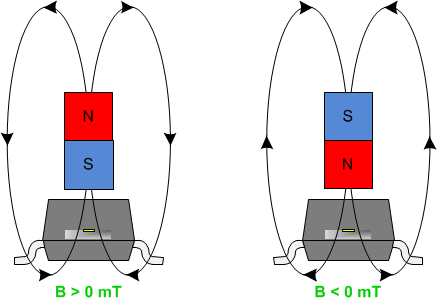SLIA086A June 2014 – December 2021 DRV5013 , DRV5013-Q1 , DRV5023 , DRV5023-Q1 , DRV5033 , DRV5033-Q1 , DRV5053 , DRV5053-Q1
3 Polarity
The symbol B is used for flux density. Most TI Hall sensors use the convention that magnetic fields traveling from the bottom of the device through the top are positive B, and fields traveling from the top to the bottom of the device are negative B. One exception is the TMAG5273 linear 3D Hall-effect sensor, which defines a positive field as when the magnetic fields travel from the top of the device to the bottom. Out-of-plane one dimensional (1D) position sensors are sensitive to the magnetic field component that is perpendicular to the die inside the package. On the other hand, in-plane 1D position sensors are sensitive to application of the magnet pole in the same plane as the die. 3D linear Hall sensors use one out-of-plane sensing element and two in-plane sensing elements to detect across three directions.
 Figure 3-1 Typical Polarity of Field Directions For 1D Out-of-Plane Sensors
Figure 3-1 Typical Polarity of Field Directions For 1D Out-of-Plane Sensors